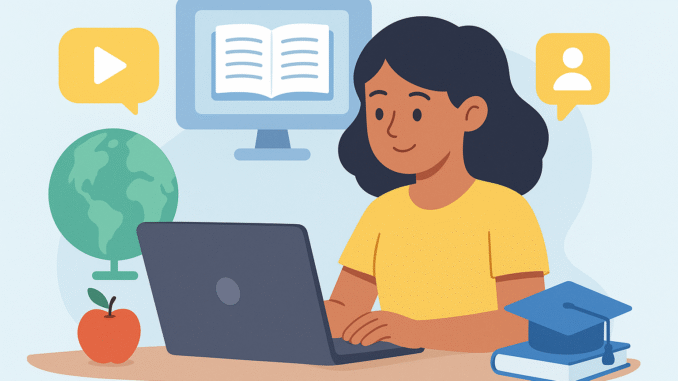
The Future of Education: How Technology Is Transforming the Way We Learn
Education has always been the foundation of human progress. From ancient classrooms under trees to modern digital platforms, the way we acquire knowledge continues to evolve. In today’s world, technology has become the driving force behind educational transformation. It is reshaping how teachers teach, how students learn, and how knowledge is accessed and shared. As we move deeper into the 21st century, the future of education looks increasingly digital, personalized, and accessible to everyone, everywhere.
1. The Digital Revolution in Education
Over the past decade, technology has rapidly integrated into classrooms around the world. Laptops, tablets, and smartphones are now as common as textbooks. The rise of e-learning platforms such as Coursera, Khan Academy, and Udemy has opened doors to millions of learners who previously lacked access to quality education.
Even before the global pandemic, digital learning was growing steadily, but COVID-19 accelerated this change dramatically. Schools and universities were forced to adopt online learning overnight. What was once considered an alternative became the primary mode of education for billions. This shift revealed the immense potential of technology to make learning more flexible, interactive, and inclusive.
2. Personalized Learning Through Artificial Intelligence
One of the most exciting developments in education technology is Artificial Intelligence (AI). AI is enabling personalized learning experiences tailored to individual students’ needs, pace, and preferences. Traditional classrooms often struggle to accommodate different learning speeds. Some students grasp concepts quickly, while others need more time and practice. AI-driven platforms solve this problem by adapting content in real time.
For example, intelligent tutoring systems can analyze a student’s performance and identify weak areas. They then provide customized exercises, explanations, and even feedback to help improve understanding. AI also powers chatbots that assist students 24/7, answering questions and guiding them through lessons without the need for human intervention.
In the future, we can expect AI-powered virtual mentors that understand emotional cues, motivation levels, and learning styles. These systems could become personalized learning companions, helping students set goals, track progress, and stay engaged.
3. Virtual and Augmented Reality: Learning Beyond the Classroom
Virtual Reality (VR) and Augmented Reality (AR) are revolutionizing the way students experience education. Instead of reading about history or science, learners can now step inside virtual worlds where they can explore ancient civilizations or conduct virtual experiments.
For instance, medical students can practice surgeries in a risk-free virtual environment, and geography students can explore the Amazon rainforest without leaving their classrooms. AR adds digital elements to the physical world, helping students visualize complex concepts such as molecular structures or physics simulations.
This immersive approach not only increases understanding but also enhances memory retention and engagement. Studies show that students who learn through interactive simulations tend to perform better and retain information longer. As VR and AR become more affordable, schools around the world will increasingly integrate them into everyday lessons.
4. The Rise of Online Learning and Global Classrooms
The internet has made education borderless. A student in a small village can now attend lectures from top universities like Harvard or MIT through Massive Open Online Courses (MOOCs). This has democratized education, making quality learning accessible to anyone with an internet connection.
Platforms such as edX, Skillshare, and FutureLearn allow students to learn new skills, earn certifications, and even pursue degrees online. The flexibility of online education is particularly beneficial for working adults, parents, and those who cannot attend traditional institutions.
The concept of global classrooms is also gaining momentum. Through video conferencing tools like Zoom and Google Meet, students from different parts of the world can collaborate on projects, exchange ideas, and learn about diverse cultures. This not only enhances academic learning but also promotes empathy and global citizenship.
5. Gamification and Interactive Learning
Education doesn’t have to be boring. The concept of gamification — applying game design elements to learning — has proven to boost motivation and engagement. Platforms like Duolingo and Kahoot! use rewards, levels, and challenges to make learning fun.
Gamified learning encourages healthy competition and collaboration. Students earn points, badges, or virtual rewards for completing tasks, which creates a sense of achievement. This method also appeals to younger generations who are accustomed to interactive digital experiences.
In the coming years, gamification will expand beyond quizzes and apps. Entire learning ecosystems will integrate game-based progression systems, allowing students to learn by doing rather than memorizing facts.
6. Data Analytics in Education
Data analytics is playing a crucial role in shaping the future of education. Schools and universities are now using learning analytics to track student performance, predict outcomes, and personalize instruction. By analyzing patterns in student behavior, educators can identify who is struggling early on and provide timely support.
This data-driven approach also helps in curriculum design. Institutions can determine which teaching methods or materials are most effective. In higher education, analytics can guide students toward suitable career paths based on their strengths and interests.
However, with the increased use of data comes the responsibility to ensure privacy and ethical use. The future of educational analytics will need strong policies to protect student data while maximizing its potential for learning improvement.
7. The Role of Teachers in a Tech-Driven World
While technology plays a central role, teachers remain the heart of education. The rise of digital tools doesn’t replace educators—it empowers them. Teachers are becoming facilitators, mentors, and guides rather than just transmitters of information.
With access to smart tools and AI-driven insights, educators can focus more on critical thinking, creativity, and emotional development—skills that machines cannot replicate. The classroom of the future will likely be a hybrid model, combining online learning with in-person collaboration and mentorship.
To succeed in this new era, teachers must also embrace continuous learning. Professional development in digital literacy, online pedagogy, and technology integration will be essential.
8. Accessibility and Inclusivity in Education
Technology has also opened doors for students with disabilities or those in remote areas. Assistive technologies like screen readers, voice recognition, and adaptive keyboards help students with visual, auditory, or motor impairments participate fully in learning.
Moreover, online education eliminates geographical barriers. Children in rural regions or developing countries can now access the same resources as students in urban centers. With initiatives like low-cost tablets and satellite internet, global education equity is becoming more achievable.
The ultimate goal of educational technology should be to create equal opportunities for all learners, regardless of their location, background, or physical abilities.
9. Challenges and Considerations
Despite its advantages, the digital transformation of education comes with challenges. The digital divide—the gap between those who have access to technology and those who don’t—remains a serious concern. Many students in low-income areas still lack reliable internet or devices.
Cybersecurity and data privacy are also major issues. As more learning happens online, protecting sensitive information becomes critical. Additionally, excessive screen time and reduced face-to-face interaction can affect students’ mental health and social development.
Balancing technology use with human connection will be key to building a sustainable education system of the future.
10. The Road Ahead
Looking ahead, the future of education will likely blend traditional and digital methods into a hybrid learning ecosystem. Classrooms will be smarter, powered by AI, and personalized to individual needs. Students will have greater control over their learning paths, while teachers will use technology to create engaging, inclusive, and meaningful learning experiences.
Education will no longer be confined to schools or universities. Lifelong learning will become the norm, with people continuously upgrading their skills to keep pace with a changing world.
The future of education is not just about technology—it’s about empowering learners. Technology is the tool, but curiosity, creativity, and human connection will remain the essence of learning.
Conclusion
The digital age has ushered in an era where knowledge is just a click away. Technology is not replacing education; it is redefining it. From AI and VR to gamification and online learning, the transformation is profound and irreversible. The challenge now is to ensure that technology serves as a bridge—not a barrier—to quality education for all.
The future of education is bright, inclusive, and limitless. As long as we harness technology with purpose and compassion, we can create a world where learning never stops and every individual has the opportunity to reach their fullest potential.

